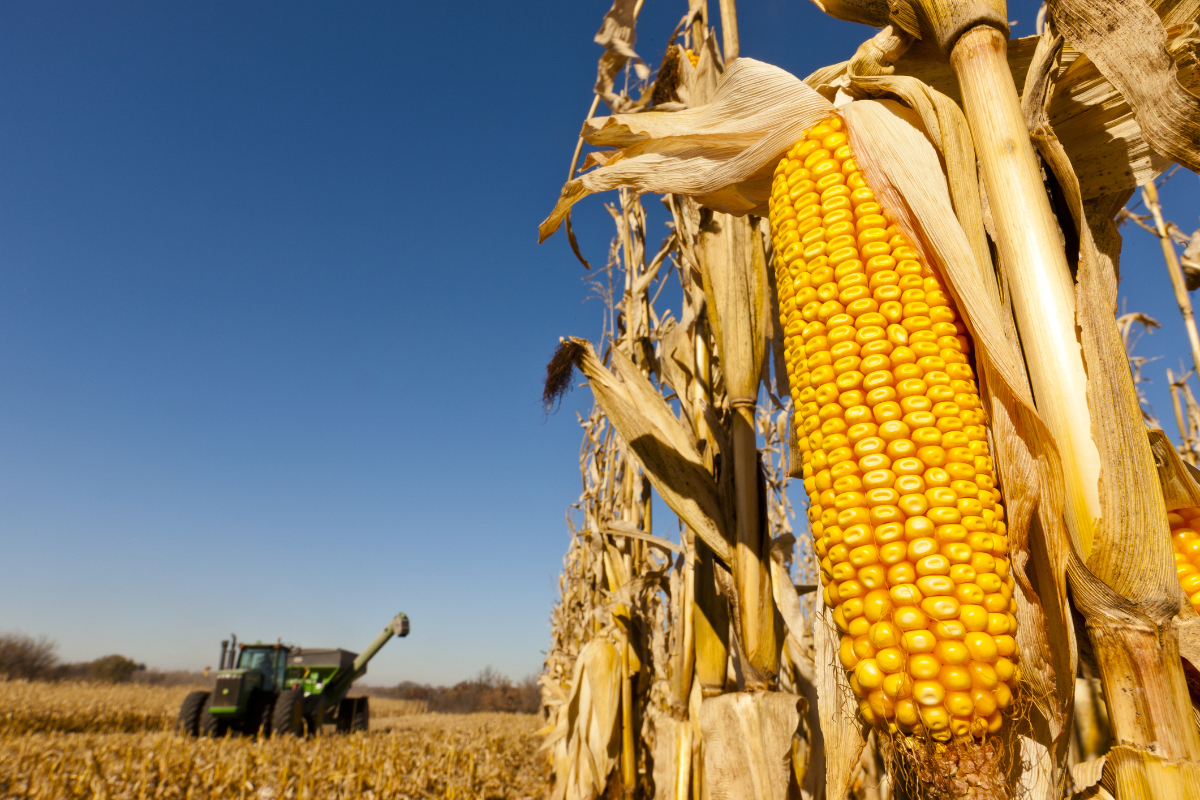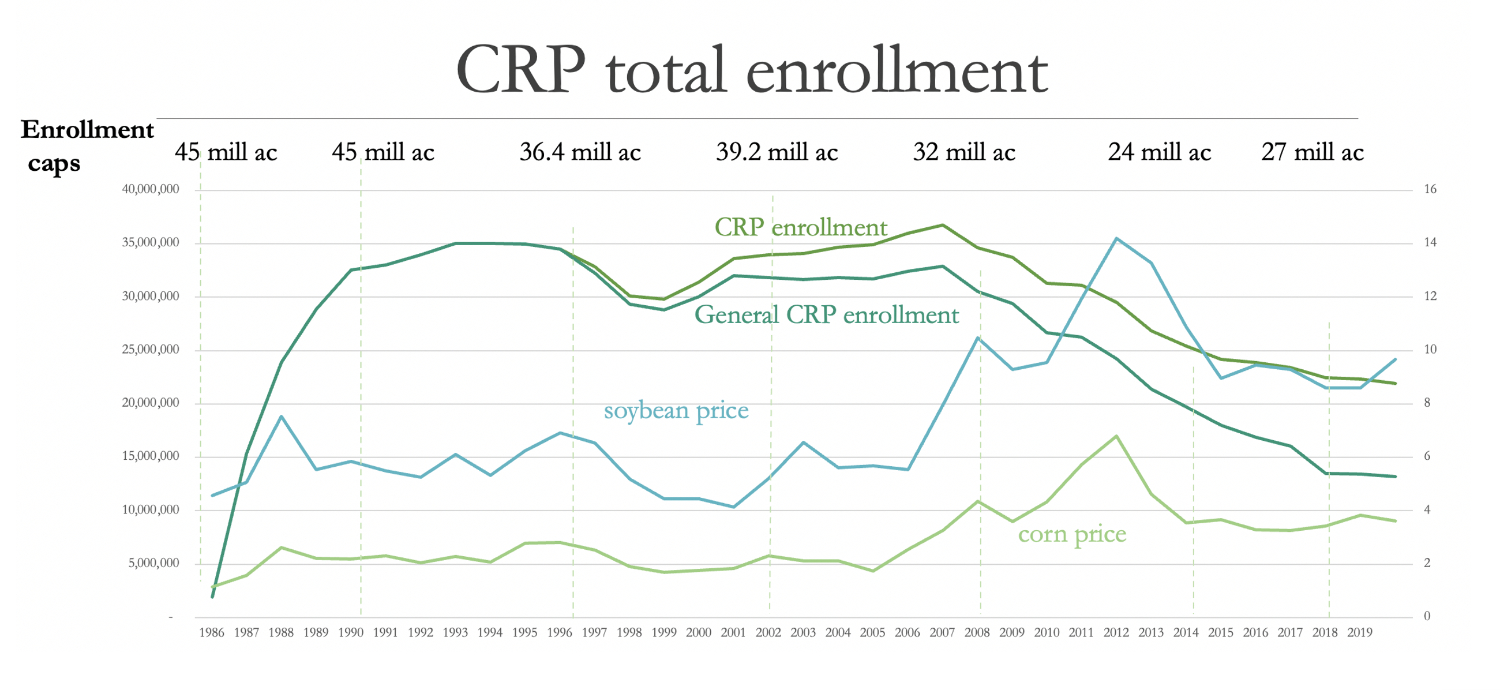|

Feb 08, 2022
By Virginia Gewin
How Corn Ethanol for Biofuel Fed
Climate Change
The Renewable Fuel Standard promised to
pay farmers to fight climate change and boost U.S. energy
independence. Instead, a new five-year study of its impact on land use
suggests it led to increased fertilizer use, water pollution,
and likely at least 24 percent more emissions than gasoline.

The U.S. is the world leader in biofuel
production—generating 47 percent of global output over the last
decade. The ten-fold expansion in ethanol production in the U.S. from
2002 to 2019 has been driven by the Renewable Fuel Standard (RFS), a
federal program that since 2005 has required transportation fuel to
contain a minimum volume of renewable fuels. So far, that has largely
meant corn ethanol. Currently 98 percent of gasoline in the U.S.
contains some ethanol, most commonly 10 percent, or E10.
For the last decade, ethanol has helped keep corn in high demand, and
made it the most-planted U.S. crop. In fact, roughly 40 percent of all
corn is now used to make ethanol. Meanwhile, the number of corn farms
over 500 acres in size has increased over time, while the number of
small corn farms is dwindling. And all this growth has led to record
profits for the companies that buy and sell the nation’s corn. For
instance, last month, Archer-Daniels-Midland, the food processing and
commodities trading giant, reported its highest-ever earnings, a net
income of over $2.7 billion, due in large part to rising biofuel
demand.
Despite the promise that the RFS would
reduce greenhouse gas emissions, a new study published in the journal
Proceedings of the National Academy of Science (PNAS) today finds that
expansion of U.S. corn cultivation has come at eye-popping
environmental costs. Corn production expanded by 8.7 percent, or 2.8
million hectares (6.9 million acres), between 2008 and 2016. As a
result, the researchers found that nationwide annual fertilizer use
surged by 3 to 8 percent and water pollutants rose by 3 to 5 percent.
The sheer extent of domestic land use change, however, generated
greenhouse gas emissions that are, at best, equivalent to those caused
by gasoline use—and likely at least 24 percent higher.
For the last decade, ethanol has
helped keep corn in high demand, and made it the most-planted U.S.
crop. In fact, roughly 40 percent of all corn is now used to make
ethanol.
That’s because the RFS caused corn prices to spike by 30 percent and
soybean and other crops by 20 percent. As a result, farmers planted
corn everywhere they could, replacing other crops and pastureland, and
plowing up land that had previously been reserved for conservation
purposes. They also often skipped the soybeans in their rotations,
despite the potential impacts on their soil.
Tyler Lark, who studies land use change at the University of Wisconsin
at Madison, has been tracking cropland expansion for years, but the
burning research question in his field has been: To what degree have
biofuels driven that expansion? Lark teamed up with agricultural
economists and water quality experts for five years to produce what is
one of the most comprehensive studies to date.
The bottom line is bluntly straightforward. “If you crank up demand,
you get land use change,” says Lark, who is also a co-author of the
new study. Every major agency in the U.S. that puts out data,
including the U.S. Department of Agriculture (USDA), the U.S.
Geological Survey (USGS), and the Environmental Protection Agency
(EPA) have all observed this rapid cropland expansion, adds Lark.
Previous studies, however, dramatically underestimated the impacts
those land use changes had on carbon emissions; in fact, the models
treated the land that was converted from conservation or pasture as if
there was little change in the amount of carbon stored once it was
planted with corn—which runs counter to existing empirical evidence.
The new study comes at a crucial moment. This year, the Biden
administration will reset the biofuel volume targets of the RFS, and
it’s yet to be seen how new targets could ultimately impact the price
of corn, demand for soybeans to make biodiesel, the farms that produce
these crops, and—ultimately—the dead zone in the Gulf of Mexico.
Plowing up Carbon
Lark’s findings are the latest evaluation of the hotly contested
biofuel carbon footprint. Several disparate data sources have
confirmed the overall trend of grassland-to-cropland conversion in
recent years, but researchers have used many different methodologies
and assumptions to analyze that footprint over the years, leading to
divergent estimates of greenhouse gas emissions resulting from the RFS.
The current study used the survey-based USDA National Resources
Inventory (NRI), which had been endorsed previously by the Renewable
Fuels Association, a trade association for the ethanol industry, to
quantify cropland expansion area and the portion attributable to corn
ethanol. Still, the organization criticized the findings.
“The claims in this report simply don’t align with reality and the
facts on the ground. By slapping together a series of worst-case
assumptions, cherry-picked data, and disparate results from previously
debunked studies, the authors created a completely fictional and
erroneous account of the environmental impacts of the Renewable Fuel
Standard,” said Geoff Cooper, president and CEO of the Renewable Fuels
Association in the statement responding to the study. (Requests for
comment from the National Corn Growers Association and the Iowa
Renewable Fuels Association were not returned.)
Given the differing estimates of
greenhouse gas impacts, Jeremy Martin, director of fuels policy at the
Union of Concerned Scientists (UCS), doesn’t think asking whether corn
ethanol is better or worse than gasoline is the most important
question. “I don’t think that biofuels are going to go away. But
clearly they’ve had an impact on water quality and fertilizer
usage—which are important findings to consider when setting future
biofuels policies,” he says. He suggests a more relevant question is:
How many acres of corn can farms plant while still meeting water
quality or conservation goals?
The federal Conservation Reserve Program (CRP), which pays farmers to
keep some of their land uncultivated, saw the acreage in the program
decrease precipitously after 2007 as farmers chose to capitalize on
high corn prices. As a result, the carbon storage gained via the CRP
was lost to the atmosphere. And now, the CRP is at its lowest
enrollment in over 30 years—while the USDA just announced it plans to
spend $1 billion to encourage carbon sequestration in soil.
The Conservation Reserve Program (CRP),
which pays farmers to keep some of their land uncultivated, saw the
acreage in the program decrease precipitously after 2007 as farmers
capitalized on high corn prices. The CRP is now at its lowest
enrollment in over 30 years.

Image courtesy of Silvia Secchi. Read about the
difference between Conservation Reserve Program (CRP) enrollment and
general CRP enrollment.
Secchi says 15 years ago, corn ethanol was touted
as a means to energy independence as well as a climate change
mitigation strategy. “But the U.S. is effectively energy independent
with fracking, so that’s out the window,” she said. “The second
argument—that it would reduce net greenhouse gas emissions—is
destroyed by this paper.”
In addition to its role as a force for change for Corn Belt farms,
ethanol has also become a cornerstone of Midwest politics. With 42
ethanol plants, Iowa is the nation’s biggest producer of both corn and
ethanol. Political support for biofuels inevitably cites the
industry’s economic importance to the region, and its role in keeping
rural economies afloat.
Some say the numbers behind that narrative are routinely overinflated,
however. The latest renewable fuels industry estimates claim 46,000
jobs through the Iowa economy, but Iowa State University economist
Dave Swenson says he can only find around 7,200 jobs. By Swenson’s
calculation, counties with ethanol plants actually averaged larger
population declines, grew merely 0.2 percent more as measured by wage
and salary jobs, and had a higher rate of farm proprietor decline.
“Ethanol has not been any sort of a game changer for rural Iowa’s
overall economies or their demographics,” says Swenson.
Corn’s Impacts Are Visible in the Gulf
The downstream costs of expanded corn production are increasingly
difficult to ignore.
According to the new study, the states with the largest expansion of
corn cultivation, between 50 to 100 percent, were North and South
Dakota, western Minnesota, and other states further to the south in
the Mississippi alluvial plain. The increased fertilizer use caused by
more corn acres likely contributes to the nutrient pollution that
causes the annual dead zone in the Gulf of Mexico. In 2021, more than
6,300 square miles of Gulf Coast waters, the equivalent of more than 4
million acres of fish habitat, were starved of oxygen—over three times
larger than the 2035 target set by the task force working to shrink
the dead zone.
In another example of this trend, the state of Illinois—where farmers
planted 11 million acres of corn in 2020—aimed to reduce nitrates and
nitrogen by 15 percent and phosphorus by 25 percent by 2025, but a
recent report indicates that nitrogen loss actually increased by 13
percent and phosphorus losses increased by 35 percent during that
time, as farmers planted an unprecedented number of corn acres.
“In places like Iowa, where farmers typically rotated corn and
soybeans, we see a lot more continuous corn or three-year rotations of
corn, corn, soybean,” says Secchi. She has also pointed to the fact
that Iowa farmers receive the most federal subsidies in the country,
meaning that taxpayers are essentially paying farmers to continue and
expand practices that reduce soil health, maintain a dead zone that
costs $2.4 billion in disrupted fisheries and damaged marine habitat,
and at best generate the same carbon emissions as gasoline.
‘Fueling Jets with Vegetable Oil Is Even Worse Than Fueling Cars’
In 2008, contrary to EPA models suggesting otherwise, Timothy
Searchinger, a senior researcher at Princeton University’s Center for
Policy Research on Energy and the Environment, was one of several who
predicted that using U.S. croplands for biofuels would increase
greenhouse gas emissions through land use change. Now, his assessment
has been validated by the new study. Searchinger says the new study
boils down to a simple, inescapable truth: Using land has a cost. And
some uses simply don’t make sense because the cost is too high.
“It’s crazy to use this very limited resource—highly productive
land—for energy,” he said. “It’s almost spectacularly inefficient.”
Corn ethanol converts 0.15 percent of solar energy into usable energy,
while a solar cell today converts 15 to 20 percent of sunlight to
energy. “And the good news is you don’t need to put a solar cell on
the best available farmland.”
The fact that the study only focuses on greenhouse gas emissions
within the U.S., likely reveals only a fraction of the impact. “The
international effects are undoubtedly larger than the domestic
effects,” says Searchinger.
“It’s crazy to use this very limited
resource—highly productive land—for energy. It’s almost spectacularly
inefficient.”
Secchi says corn isn’t like other crops.
Agricultural innovations over the last century have led to a system
that produces so much of it that the agriculture industry has often
found itself manufacturing demand to meet the supply. “It’s time to
factor in the broader impacts of creating that demand,” she adds.
“We currently use over one-third of the corn we
produce for biofuel, and it offsets 6 percent of gas use. We could get
the same benefit by increasing fuel economy of cars from 22 to 24
miles per gallon,” says Jason Hill, a bioenergy researcher at the
University of Minnesota.
Although the RFS targets have had an important impact on corn
production in the past, it’s not clear whether they will be an
important lever going forward. “Right now, corn ethanol consumption
isn’t even meeting the targets of the RFS, but even if you got rid of
these policies, you probably wouldn’t sell substantially less ethanol
(than the current 10 percent blending rate),” said Union of Concerned
Scientists’ Martin. (That said, the Iowa governor is pushing
legislation that would require the state’s gas stations to have at
least one pump at each station carry E15, a 15 percent ethanol
blending rate.)
At the same time, the efficiency of electric vehicles is also expected
to complicate the future demand for ethanol. And with this in mind,
the budding biofuel industry is turning its attention to vegetable oil
production to make other fuels.
“Post-2022 RFS targets are very unlikely to lead to dramatic increases
in ethanol use. In the last decade, RFS policy has had a much more
dramatic effect on the use of vegetable oil-based fuels, especially
biodiesel” says Martin. “And looking forward, renewable diesel and
sustainable aviation fuel could add substantially to the use of
vegetable oil for fuel.”
That shift could create a similar—and likely more devastating—impact.
Fueling jets with vegetable oil is an even worse idea than fueling
cars, says Searchinger. Oil production requires even more land than
starches do and new sources of vegetable oil would likely cause
soybean and palm oil expansion in the tropics. “You could have
staggering environmental effects if, for example, half of the aviation
fuel is supposed to come from biofuels by 2050,” he explains.
Either way, it’s clear that the RFS presents an important crossroads
for the future of biofuel production—and the land on which it is
farmed. As study co-author Lark put it: “Decisions made this year have
the potential to impact our climate and landscape for decades to
come.”
Green Play Ammonia™, Yielder® NFuel Energy.
Spokane, Washington. 99212
509 995 1879
Cell, Pacific Time Zone.
General office:
509-254
6854
4501 East Trent
Ave.
Spokane, WA 99212
|